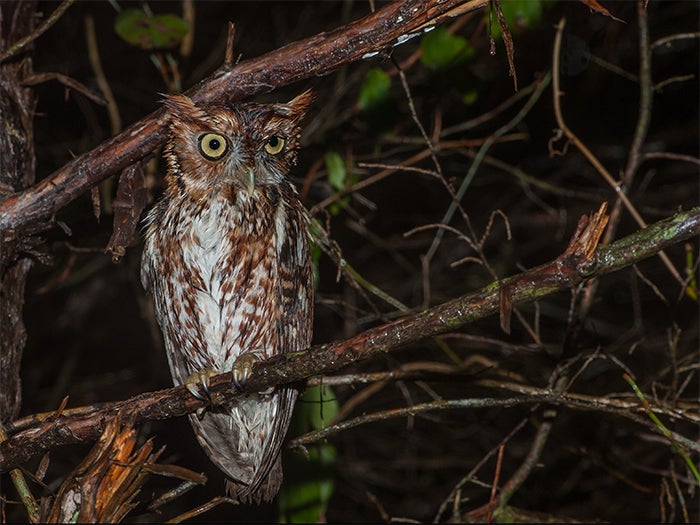SCIENTIFIC NAME:
Megascops asio
OTHER NAMES:
Common screech owl; gray owl; little cat owl; little dukelet; little horned owl; mottled owl; red owl; scritch owl; shivering owl; squinch owl; whickering owl; whinnying owl.
STATUS:
Breeder. Common in all seasons and regions. Low Conservation Concern.
DESCRIPTION:
The Eastern screech owl (Otus asio) is a small mottled owl with prominent ear tufts. It is the smallest owl with ear tufts in the eastern United States. Its body size ranges from 6.3 to 9.8 inches with females and males weighing approximately 6.8 and 5.9 ounces, respectively. The Eastern screech owl has two color phases: a brown or rufous phase and a gray phase with an intermediate phase that is mottled reddish brown with gray. Color phases, which vary in proportion geographically, are not based on age, sex, or season. The wingspan of Otus asio ranges from seven to 10 inches. One of the most strictly-nocturnal members of this family, the Eastern screech owl is probably the best-known small owl in eastern North America. The voice of Otus asio is easily recognizable by its tremulous, descending wail with soft purrs and trills. The call is not a screech but rather a soft, mournful whinny that can be heard most often in the fall and spring months of the year.
DISTRIBUTION:
Otus asio can be found in southern, central, and eastern Canada, south to the Gulf Coast of Florida and northeastern Mexico.
HABITAT:
The Eastern screech owl can be found in open deciduous woods, wood lots, suburban areas, lake shores, and old barns. Roosting during the day in hollow trees where it sits facing the bright daylight, Otus asio can see in the brightest daylight but prefers to remain hidden in dark corners of old buildings or other dark areas for protection. When discovered during the daylight hours, it often freezes in an upright position relying on cryptic coloration to escape detection.
FEEDING HABITS:
The diet of the Eastern screech owl is an array of various items that are captured by the bird’s straight perch-to-prey strikes. Hunting by Otis asio is usually done soon after dusk under the shelter of darkness. Dietary material includes insects, frogs, salamanders, rodents, crayfish, snakes, lizards, fish, snails, scorpions, spiders, crickets, ants, cicadas, and moths. The Eastern screech owl has been reported to have killed domestic pigeons, quail, ruffed grouse, American woodcock, sparrow hawks, and many other small birds with its needle-like talons.
LIFE HISTORY AND ECOLOGY:
The Eastern screech owl usually lays three to four white, oval or round, eggs in a cavity of an old tree or in a bird box without a nest lining. Eggs may also be found in hollow stumps or abandoned nesting holes (mostly of the common flicker) in sycamores, elms, dead pines, and oaks. Egg-laying usually occurs from February to July. The 26-day incubation period is handled largely by the female of the species, but the male may roost in the nesting hollow during the day while the female is incubating. The male Eastern screech owl provides food for the female while she incubates. The young owls will fly about 28 days after hatching. The young usually remain dependent on the parents for eight to 10 weeks. Screech owls are fearless when defending their nests and will often strike an unsuspecting human on the head as he passes nearby at night.
REFERENCES:
Grzimek’s Animal Encyclopedia, 2nd ed., Volumes 9-11, Birds I-IV, Gale Group, Farmington Hills, MI, 2002.
John Bull and John Farrand Jr., The Audubon Society Field Guide to North American Birds, Chanticleer Press, Inc., New York, 1990, pp. 279-80; 634-35.
John K. Terres, The Audubon Society Encyclopedia of North American Birds, Wings Books, New York, 1991, pp. 670-71.
AUTHOR:
Bennett Moseley, Wildlife Biologist, Alabama Division of Wildlife and Freshwater Fisheries






